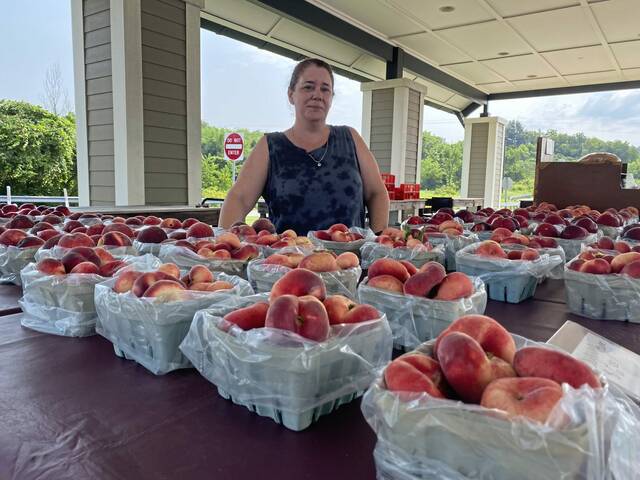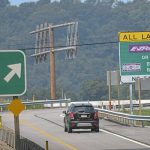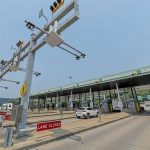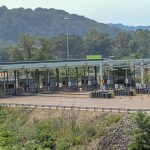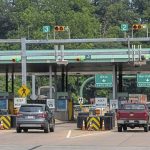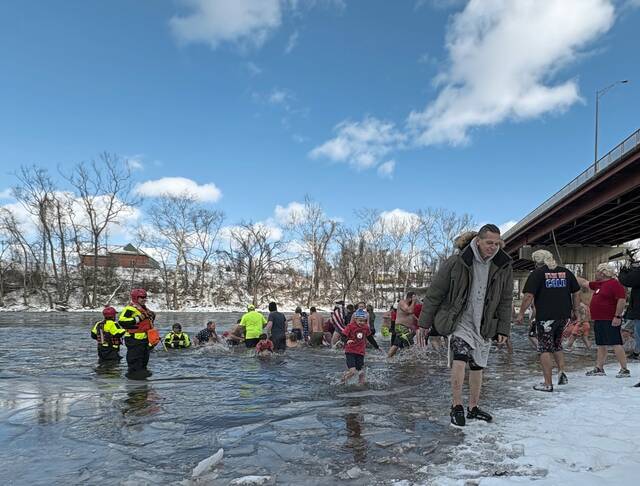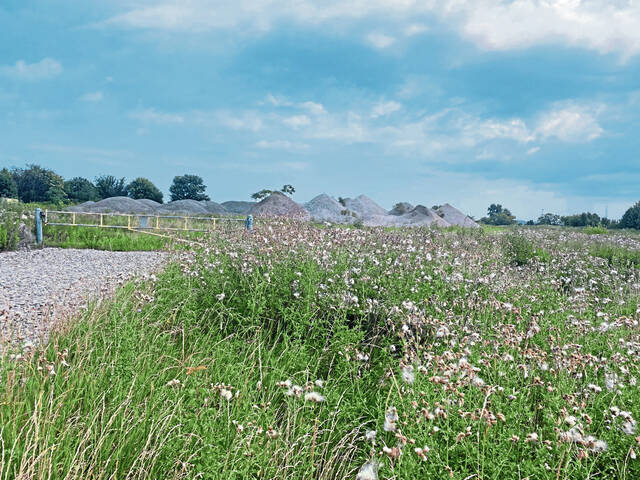Surrounded by bushels of fresh local peaches, Lori Hanscom spent an afternoon greeting truckers, commuters and vacationers from behind her fruit stand at the New Stanton rest stop along the Pennsylvania Turnpike.
Her day was filled with friendly chatter about the weather, traffic and which fruits were in season. One topic always surfaced: skyrocketing turnpike tolls.
Fares have increased each of the past 13 years and will continue to rise until 2050. The most recent 5% increase will take effect in January.
“You would think there would be other ways to pay for this without bleeding people dry,” Hanscom said as she stacked peaches.
In 2004, the cost to travel the turnpike from the Ohio border to the New Jersey line was just over $21. Today, the same trip costs $47 — for E-ZPass users. For other drivers, the cost is $95.30, paid via Toll-by-Plate — a machine that scans license plates and sends a bill.
The turnpike went cashless in June 2020.
Some businesses, already squeezed by the covid-19 pandemic, have seen tolls cut deeply into their bottom line.
Don Mahalko, a trucker for Block One Logistics in Chicago, estimated the company has experienced an 8% decrease in revenue as a result of increased tolls during the past few years.
Despite that, the turnpike remains the quickest route for Mahalko’s three or four monthly trips across the state.
“You’re kind of limited, so you have to use it to make time for travel,” Mahalko said.
While experts agree the constantly increasing tolls are worrisome, they are equally troubled by the amount of debt the Turnpike Commission has incurred over the past decade.Most of it stems from $450 million yearly payments to the state Department of Transportation, which started in 2007 under Act 44.
“You can’t keep borrowing because now the turnpike’s finding themselves behind the eight ball in debt,” said Frank Gamrat, executive director of the Allegheny Institute for Public Policy, a Castle Shannon-based think tank.
Act 44 was designed to help fund statewide transportation projects without raising taxes. The cornerstone of the plan was converting Interstate 80 into a toll road along with creation of a lease agreement between the Turnpike Commission and PennDOT. The plan hit a snag when the Federal Highway Administration denied the plan for I-80.
As a result, a default clause written into Act 44 took effect and required the Turnpike Commission to pay PennDOT $450 million a year, funded mostly through bonds. To date, the commission has paid $7.9 billion, accumulating more than $14 billion in debt, records indicate.
That amount is equivalent to Pennsylvania’s total statewide debt, records show.
PennDOT officials say the funding is crucial to maintain the agency’s current level of service.
The money is used for everything from road improvement projects to public transit, bike lanes, pedestrian walkways, accessibility for the disabled and work at state ports, PennDOT Deputy Secretary Jennie Granger said.
Those payments sent tolls skyrocketing, critics say.
“Before Act 44, the turnpike only increased tolls five times in 64 years,” according to a 2019 report from the state Auditor General’s Office, the most recent detailed report available.
Annual hikes are expected until at least 2050 for the toll road that opened in 1940 and was touted worldwide as an engineering marvel.
Turnpike spokesman Carl DeFebo Jr. said commissioners reassess the need for toll increases each year.
The commission expects 5% yearly increases from 2022-25, a 4% increase in 2026, a 3.5% increase in 2027 and 3% increases from 2028-50, records show.
DeFebo said the financial impact on drivers is significant, so the Turnpike Commission and PennDOT are looking for alternative sources of funding.
“We have to work together on a solution, and we are,” he said. “That solution in 2007 was using toll revenue to help fund transportation within the commonwealth.”
Pumping the brakes
In comparison to similar toll roads in other states, the Pennsylvania Turnpike’s net position — a figure calculated by accounting for toll revenues and outstanding debt — is deteriorating rapidly, according to the auditor general’s report.
The report showed the turnpike’s overall net position was about $2 billion in 2007. When Act 44 went into effect in 2008, the turnpike began a financial downslide. In 2017, that figure was $5.64 billion in the hole — the lowest, by about $5 billion, of four states bordering Pennsylvania (Ohio, New Jersey, New York and West Virginia) that sustain large-scale turnpikes.
The pandemic has worsened the commission’s financial situation.
Toll revenue dropped in 2020 because fewer people commuted during the pandemic and more companies implemented remote work programs.
Despite an increase in traffic this spring and summer, DeFebo said, toll revenue is still about 10% less than in 2019, when there was an annual 3% to 4% increase.
He estimated it will take three years for the turnpike to fully recover from pandemic-related losses.
“It’s so hard to look into a crystal ball, but we’re not expecting a brisk return,” DeFebo said.
Turnpike usage nationwide dropped in 2020 by about 60%, said Mark Muriello, director of policy and government affairs at the International Bridge, Tunnel and Turnpike Association. So far this year, it has rebounded in most places to at or above 2019 levels.
Some people say their decision to steer clear of the turnpike has nothing to do with the pandemic.
Every weekday for 15 years, Linda Echard drove from her New Stanton home to Monroeville for her job as a principal in the Gateway School District. Lately, she has looked for alternative routes as tolls doubled — now to $5.40 round-trip.
“I’m not sure the price hikes they have are proportional with (the Turnpike Commission’s) need,” Echard said.
Hanscom told a similar story. She sharply criticized the $5 toll to make the short trip to visit friends and family in Jeannette or Irwin. Most days, she takes other routes to avoid the tolls.
Nearly a decade ago, legislators took action to remedy the Turnpike Commission’s mounting debt.
A law that passed in 2013 drops annual payments to PennDOT starting after the 2022 fiscal year from $450 million to $50 million. Under Act 89, PennDOT is to receive $400 million from the state general fund to compensate for that loss.
But the damage had already been done, experts said.
First to most expensive
Senate Majority Leader Kim Ward, a Hempfield Republican who previously chaired the Senate Transportation Committee, said the Turnpike Commission remains on the hook to make smaller payments to PennDOT and continue paying off debt it incurred over the years with much larger payments.
She said lawmakers are aware of the growing burden.
She pointed to Senate Bill 737, which was introduced this year to help reduce Turnpike Commission costs. Supporters said the measure could save the commission an estimated $170 million a year by exempting it from environmental regulations that drive up the cost of construction and improvements.
Elizabeth Stelle, a policy director for the Commonwealth Foundation, advocates for a more radical approach.
“We have revisited the original idea to raise funds for transportation, which was private management of the turnpike,” said Stelle, whose think tank looks at state issues from a free-market perspective. “We are advocating for a return to that idea. We believe a well-written contract is an excellent way to utilize resources like (the turnpike).”
That idea, pitched in 2007 by then-Gov. Ed Rendell, went down in flames when it was revealed the likely lessor was a Spanish company that had joined forces with a Wall Street firm.
“So we ended up with this hodgepodge bill that led to significant debt,” Stelle said. “We’re now the most expensive toll road not only in the nation but in the world.”
Since that time, Stelle said, several private management deals have shown that such arrangements can benefit the public, given strict parameters on lease terms and toll increases. She said even the deal the Rendell administration broached would have set strict limits on toll increases — and well below the jumps seen since Act 44 took effect.
DeFebo said the Turnpike Commission is cognizant of its financial status and has worked diligently to pare operating costs. Faced with the impact of its state funding obligations and dwindling revenues because of a pandemic-fueled traffic decline, the commission furloughed 500 toll collectors and made cashless collections permanent. It also cut capital spending by 25%, froze hiring and offered voluntary retirements.
Toll revenue could be part of this solution, DeFebo said. But he added that it will “take a lot of minds and more than one source of revenue” to solve the problem. The Turnpike Commission estimates that eliminating toll-takers will save about $70 million a year — $50 million in reduced personnel costs and $20 million in reduced maintenance and operations cost.
As the commission searches for alternate funding sources, he recognized the hardship on riders caused by Act 44 and the subsequent toll increases.
“We know this has been a lot to shoulder for our customers,” DeFebo said.
Said Hanscom, while standing watch over her peaches, “There has to be a better way to do things.”



